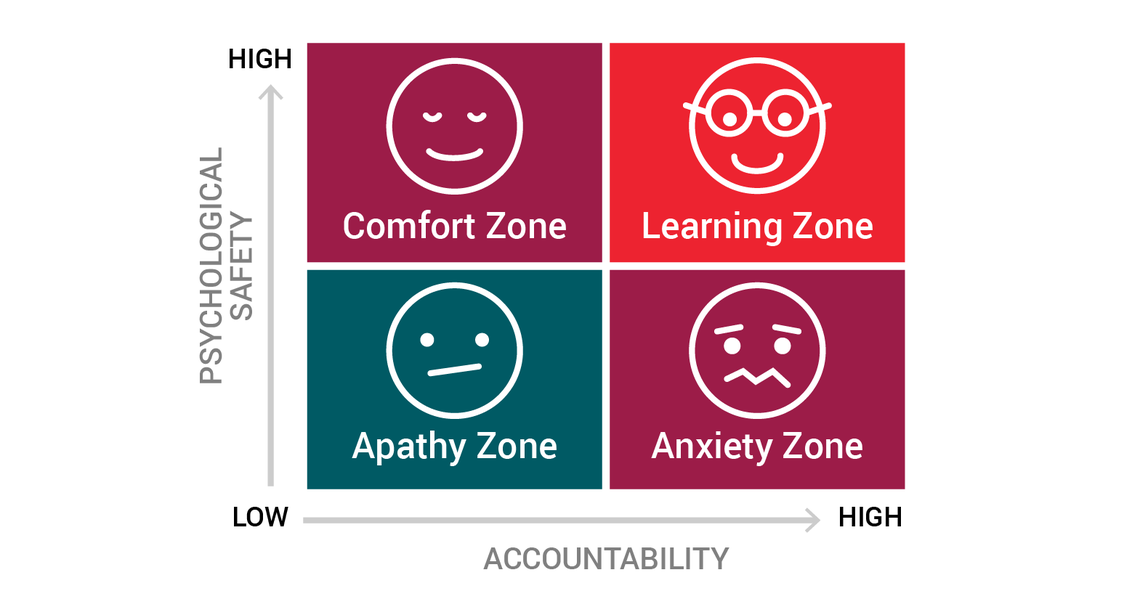Psychological safety–what is it?
uring the pandemic, we have thought a lot about the physical safety of our colleagues, staff, patients and selves. Do we have the right PPE, are we testing enough, how do we distribute the vaccine and encourage its use? It is equally, if not more, important to think about the psychological safety of those same team members and patients. Psychological safety is critical for our teams to function safely, learn from mistakes and innovate.
When Dr. Amy Edmondson was asked to examine medical errors through the lenses of team dynamics and communication, she hypothesized that teams that communicated better would make less errors. But when she looked at her data, she found that teams with higher communication ratings had more medical errors.
A closer assessment of these teams’ actions revealed surprising results. Although the teams that communicated better were indeed reporting their errors, the teams with worse communication ratings were actually making more medical errors but weren’t reporting them to the system.
The teams with better communication viewed mistakes as part of the learning process and used them as opportunities for improvement and innovation. For teams with poor communication, medical errors weren’t chances for growth—they were grounds for punishment or humiliation.
Based on her findings, Dr. Edmondson coined the term “psychological safety,” or the belief that one should not be ridiculed and punished for speaking up with ideas, questions, concerns or mistakes.
Psychological safety is about cultivating a work environment where people feel comfortable being and expressing themselves.
Combating the Common Knowledge Effect
When we work in a system where we’re under psychological danger or threat, we often allow fear to dictate our actions. We’re afraid of making mistakes, so we’re more apt to blame others when mistakes do happen. Instead of working in unison, team members are too scared to speak up and offer different ideas or opinions.
This leads to the common knowledge effect. When information that is held by the most people in a group has the strongest impact on the team’s decisions, that information will be propagated in order to maintain the status quo. If no one steps up to challenge that information and offer new insight, effective decision-making and innovation will grind to a halt.
In systems that encourage psychological safety, people feel comfortable admitting mistakes. Everyone is expected to share their mistakes, so that the team can learn and grow from that failure. Decisions inherently become more effective and creative.
Psychological safety is particularly crucial in health care environments, because we often find ourselves in situations where the outcome is not predetermined. When we must be flexible and adapt quickly, communicating honestly with our team becomes vital. If you’re operating within a system that disparages you for speaking up or questions your mental health when you make a mistake, you won’t feel safe enough to step forward.
Speaking out shouldn’t be a calculated risk—it should be inherent.
How do teams create psychological safety?
Facilitating psychological safety within a team takes a concerted effort. These four quadrants serve as the building blocks for creating a psychologically safe environment:
Psychologically safe team dynamics

Learner safety: Team members should feel comfortable asking questions, experimenting, learning from each other’s mistakes, and looking for new opportunities.
Collaborator safety: Team members should participate in open dialogue, have mutual access to each other, and engage in constructive debates.
Challenger safety: People should feel comfortable challenging the status quo if they identify changes that need to be made, even if those changes are unpopular or difficult. Team members should be encouraged to speak up and expose problems.
Inclusion safety: Team members need to feel valued. Everyone should know that their experience and ideas matter equally, regardless of their title or rank. Members should be comfortable contributing to the group.
Psychologically safe environment
Creating the ideal environment for growth and productivity requires a balance between psychological safety and accountability. The four zones of psychological safety—learning, comfort, apathy and anxiety—reflect shifts in that balance.

Learning zone: In a learning zone, team members experience high accountability and high psychological safety. This is the ideal learning environment for innovation and growth, because even though members are responsible for their actions, their team offers continuous support.
Comfort zone: Team members have high psychological safety and low accountability. While this zone is more relaxed, almost like a vacation, there is no push for creativity and growth.
Apathy zone: With low psychological safety and low accountability, team members fall into the apathy zone. There are no repercussions for mistakes, teams lack adequate communication and support, and individuals struggle to care about their work.
Anxiety zone: Team members experience low psychological safety and high accountability. Communication breaks down and when mistakes are made, people are often too scared of punishment or humiliation to take responsibility. Opportunities for learning and innovation are scarce.
Six behaviors of psychologically safe leaders
As a leader, cultivating a healthy work environment for your team falls on your shoulders. These six behaviors will help you demonstrate the importance of psychological safety:
- Set the stage: First and foremost, acknowledge your own mistakes. Fallibility isn’t a crime and showing your team that it’s okay to be vulnerable will encourage them to be transparent with their mistakes too.
- Frame the work as a learning process: There is a lot of uncertainty in health care. We must rely on each other and be open and responsive to feedback.
- Establish norms: Make behavioral norms explicit and develop clear roles and processes, especially with new team members. Ask and respect how your employees prefer to communicate and receive feedback.
- Model curiosity: Ask questions, and express genuine interest in the answers. Reinforce those who ask questions by thanking them and encouraging participation. Try to approach conflict through a lens of curiosity, rather than confrontation. For instance, if one of your team members is struggling to complete a project, say: “Oh, I see you missed your deadline for this, what can we do to get you back on track?”
- Use strengths-based approach: Ask your team: What can we count on each other for? A person might think that one of their strengths is something that everyone has or might not even be aware that it is a strength. Help each member understand what they bring to the team.
- Take care of each other: Check in on teammates, even if that just means being aware if they need space to take care of their own needs. Also, assume positive intent. If one of your team members seems distracted, give them an opportunity to explain themselves.
Do’s and Don’ts of psychological safety
We can implement a psychologically safe workplace by adopting a culture of appreciation, where we recognize achievements and successes. By creating space for new and different opinions and encouraging transparency, we can enhance our communication channels and make better decisions.
We also need to recognize that being open to new ideas takes a concerted effort. Be conscious of your actions, and avoid blaming teammates, pulling rank, or shutting down opinions that are different than your own. If you see a fellow member struggling, don’t assume they can handle it on their own—offer your support.
Fostering a psychologically safe environment leads to better learning opportunities, increased innovation, and improved patient safety.
The Complete Clinician Model Toolkit
This article is part of the Complete Clinician Model Toolkit.
The toolkit provides resources for individuals and teams to build and integrate relationship management skills into daily training and work.
References
-
Creating Psychological Safety in the Workplace (HBR 2019) Podcast interview with Harvard Business School professor Amy Edmondson on leading teams with psychological safety.
-
How to Create a Culture of Psychological Safety (GALLUP Workplace 2017) Organizational culture and change expert Jake Herway shares four questions that lead to psychological safety.
-
How Managers Can Create An Enviornment of Psychological Safety (Forbes 2019) Leadership strategist Jim Barnett shares thought-starters for cultivating psychologically safe teams.
-
High-Performing Teams Need Psycholocial Safety. Here’s How to Create It (HBR 2017) Stanford professor Laura Delizonna details behaviors that lead to breakthroughs in psychological safety.
-
Psychological Safety Query (YouTube 2021) From TED Talks to shop talk about all things psychological safety.
Jennifer O’Donohoe
Kristi Kleinschmit
Your social media feeds are awash with tips for working from home, but how do you lead from home? Karen Wilson and Dawn Newberry, of University Medical Billing, have led remote teams for years. Their experience boils down to one principle: build and maintain connection.
Frequent and meaningful communication is a hallmark of high-performing teams, and it matters even more during a crisis. The Resiliency Center’s Megan Call and Amy Locke share helpful resources and a list of prompts to connect your team.
To disagree means failing to agree. Synonyms include to contradict, challenge or debate. Synonyms do not also have to include to argue, quarrel, dispute, bicker or clash. Pediatric intensivist Jared Henricksen shares the best path forward when words become clouded with emotion.
